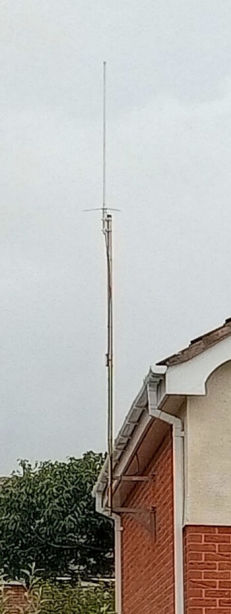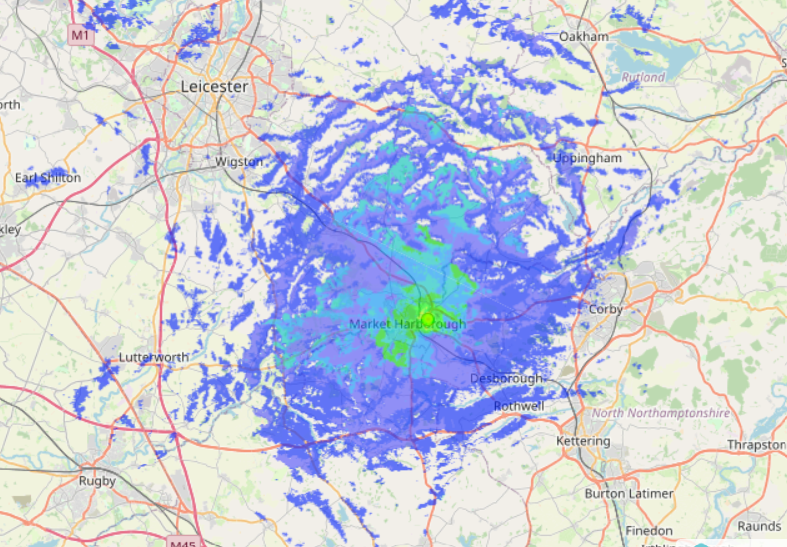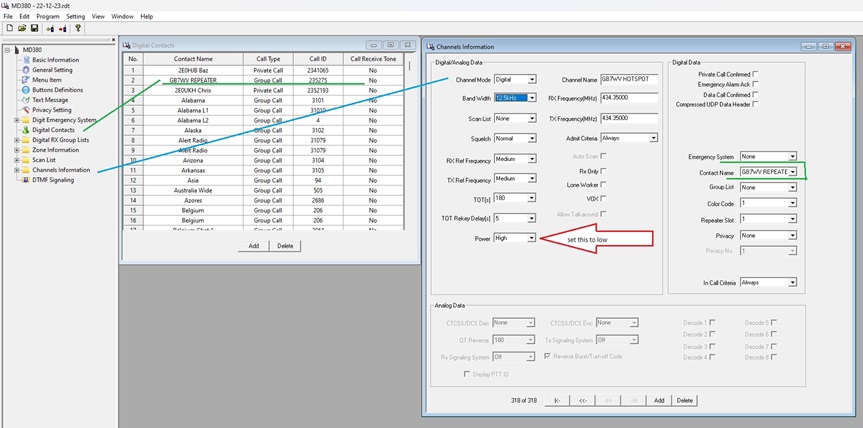GB7WV Repeater

GB7WV is our local Repeater located in Market Harborough. It is Dual Mode FM & DMR.
Since it's only licenced for low power and due to it's low altitude, the coverage is quite limited. The repeater is really only intended to serve the local area and is an ideal place to meet on the air and have a local chat.
Repeater Information
Call Sign: GB7WV
Repeater Keeper: Peter Rivers (G4XEX)
Location: Market Harborough, IO92NL
Output Frequency: 439.6875MHz (your receiver freq)
Input Frequency: 430.6875MHz (your transmitter freq)
Repeater Shift: -9MHz (your repeater shift)
GB7WV FM Configuration
Use the same TX and RX frequencies as above as well as the minus -9Mhz repeater shift.
Your transmitter also needs to have 77Hz CTCSS enabled and this is optional on your receiver.
DMR Configuration
Colour Code: 2
Repeater DMR ID: 235275
DMR Network: BrandMeister
Slot 1: 235275 (Local Chat)
Slot 2: Select your own choice of Talk Group eg TG91 etc.....
GB7WV Welland Valley Repeater - Relocation
The Welland Valley 70cms repeater GB7WV has recently been re-located to G4XEX's QTH on higher ground. So, coverage should be better than before.
The repeater is accessible using either FM mode or DMR. Previous DMR issues are now resolved on the repeater.
Please send QSL reports to WVARS
The repeater has been on the year for a few years since DMR started to be used by radio amateurs, however due to the initial cost of DMR equipment and their complicated programming as well as the repeater being located in a poor RF location it never really got the use we expected. However, the recent relocation and enabling FM mode has now made it a natural start point for our Club Sked.

Having a local UHF repeater encourages local Hams to get on the air, as it gives us a spot frequency where local amateurs can meet for a chat, or just listen to other locals having a QSO.
FM Repeater Access
Repeater Output Frequency (you listen) 439.6875MHz FM with 77Hz CTCSS (CTCSS optional).
Repeater Input Frequency (you transmit) 430.6875MHz with 77Hz CTCSS (CTCSS mandatory).
Once your radio is programed, press the PTT on your radio and put a CQ call out. If your within RF range, and as long as you transmit with a 77Hz CTCSS tone enabled for about 3 seconds you should get a "K" (dah-dit-dah) from the repeater to acknowledge you have made it into the repeater. A short press on the PTT of less than 3 seconds, will result in only getting an FM carrier with no "K" acknowledgement.
Please ensure that when replying to a CQ call on the repeater or during a conversation, that you wait for the "K" before transmitting your reply, this then allows a short gap for other stations to call into the QSO if they want to. This short gap while waiting for the "K" also gives the repeater time to switch between TX and RX.
77Hz CTCSS (sub-audible tone) is used for two reasons.
(a) The repeaters receiver needs to hear a 77Hz CTCSS tone superimposed on the FM carrier. As long as the 77Hz tone is enabled when you transmit, the repeater will repeat what it hears. If no 77Hz tone is enabled on your transmitter, then the repeater will not repeat. This stops any interference from falsely being re-transmitted by the repeater.
(b) The repeater transmits a 77Hz CTCSS tone that is superimposed on the FM carrier. This gives you the option to filter out the CWID (12wpm Morse code call sign identification) that the repeater transmits out every 10 minutes, that can be annoying for casual listeners.
If you have your receiver programmed with 77Hz CTCSS sub-audible squelch enabled, then all you will hear is the audio from other stations and the "K" at the end of an over with no CWID. However if you don't program the 77Hz CTCSS on your receiver and leave it as normal CS (Carrier Squelch), then you will also hear the repeaters call sign (GB7WV) being transmitted in Morse code every 10 minutes.
DMR Access.
This remains unchanged. The repeater GB7WV uses the same transmit and receive frequencies as the FM repeater, however the repeater is now in Dual Mode, which means it also now has FM as well as DMR access enabled.
When the repeater is in standby, it listens on both modes, until it hears either (a) an FM signal with 77Hz CTCSS or (b) a DMR signal with CC2 (Colour Code 2) selected. It then switched to that mode. After a short time of no activity, the repeater will drop back into standby and listen again for either a FM or DMR signal.
DashboardClick here to access the Dashboard
How to Program an MD380 for DMR to connect via your HotSpot to GB7WV
by Paul G1FJH
There has been some changes to the settings you need in your DMR Radio in order to use the local DMR repeater GB7WV. This has come about after I wanted to be able to link my DMR hotspot to the local repeater. This will be useful to other users if you're just outside the RF capabilities of the Repeater. For me, it means I can Monitor repeater activity or use the repeater from inside my house with a Handheld using my hotspot - Paul G1FJH
(Click the image for full size image).
(a) Firstly you need to create a digital contact (highlighted in green) You can call it what you like I called mine "GB7WV Repeater". Set the call ID of the repeater to 235275.
(b) Now you need to create a channel in your handheld or, if you already had a channel for the repeater, go in and modify that. The setting you will need to change is highlighted in Green "contact name". Click on the drop down list and you should see the contact that you created earlier, in my case "GB7WV repeater".
(c) When accessing the repeater via your hotspot, it's also worth turning the output power to low to save battery life.
(d) If you are creating a completely new channel,remember to set all of the other options to match your hotspot and add the channel to one of your zones.
73 Paul G1FJH.


